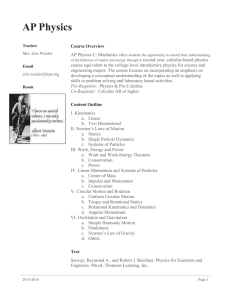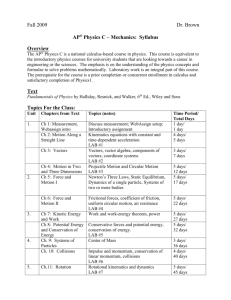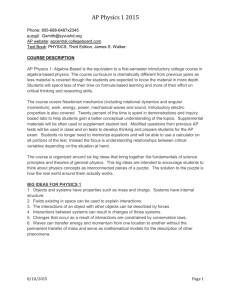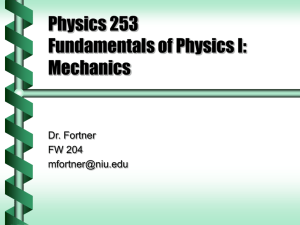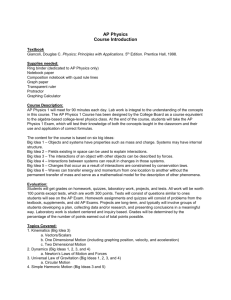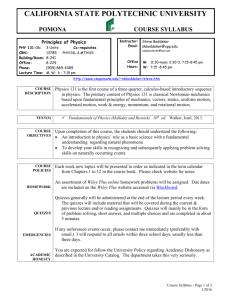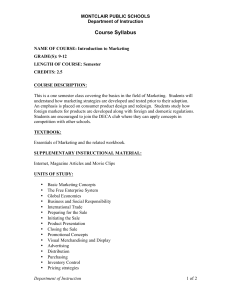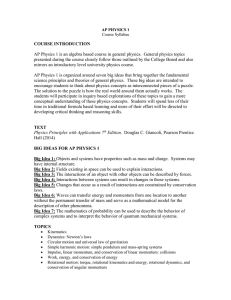AP Physics Course Syllabus
advertisement
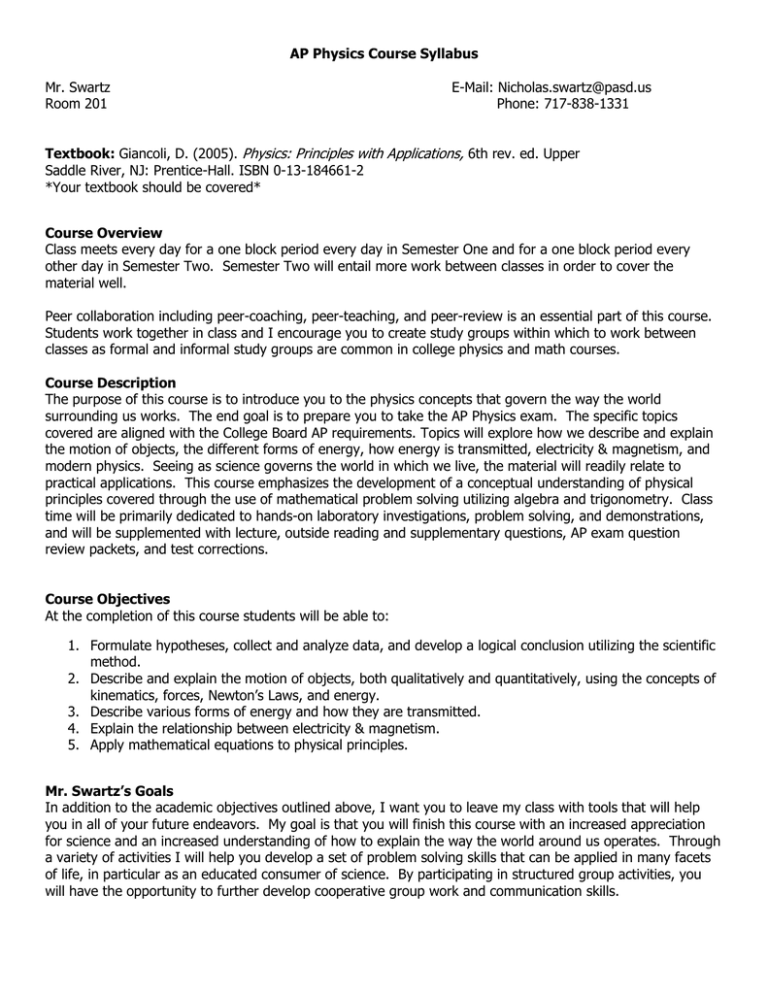
AP Physics Course Syllabus Mr. Swartz Room 201 E-Mail: Nicholas.swartz@pasd.us Phone: 717-838-1331 Textbook: Giancoli, D. (2005). Physics: Principles with Applications, 6th rev. ed. Upper Saddle River, NJ: Prentice-Hall. ISBN 0-13-184661-2 *Your textbook should be covered* Course Overview Class meets every day for a one block period every day in Semester One and for a one block period every other day in Semester Two. Semester Two will entail more work between classes in order to cover the material well. Peer collaboration including peer-coaching, peer-teaching, and peer-review is an essential part of this course. Students work together in class and I encourage you to create study groups within which to work between classes as formal and informal study groups are common in college physics and math courses. Course Description The purpose of this course is to introduce you to the physics concepts that govern the way the world surrounding us works. The end goal is to prepare you to take the AP Physics exam. The specific topics covered are aligned with the College Board AP requirements. Topics will explore how we describe and explain the motion of objects, the different forms of energy, how energy is transmitted, electricity & magnetism, and modern physics. Seeing as science governs the world in which we live, the material will readily relate to practical applications. This course emphasizes the development of a conceptual understanding of physical principles covered through the use of mathematical problem solving utilizing algebra and trigonometry. Class time will be primarily dedicated to hands-on laboratory investigations, problem solving, and demonstrations, and will be supplemented with lecture, outside reading and supplementary questions, AP exam question review packets, and test corrections. Course Objectives At the completion of this course students will be able to: 1. Formulate hypotheses, collect and analyze data, and develop a logical conclusion utilizing the scientific method. 2. Describe and explain the motion of objects, both qualitatively and quantitatively, using the concepts of kinematics, forces, Newton’s Laws, and energy. 3. Describe various forms of energy and how they are transmitted. 4. Explain the relationship between electricity & magnetism. 5. Apply mathematical equations to physical principles. Mr. Swartz’s Goals In addition to the academic objectives outlined above, I want you to leave my class with tools that will help you in all of your future endeavors. My goal is that you will finish this course with an increased appreciation for science and an increased understanding of how to explain the way the world around us operates. Through a variety of activities I will help you develop a set of problem solving skills that can be applied in many facets of life, in particular as an educated consumer of science. By participating in structured group activities, you will have the opportunity to further develop cooperative group work and communication skills. Course Outline Unit 1: Math and Data Review A. B. C. D. Measurements and Sig Figs Algebra and Trigonometry Review Dimensional Analysis Vector Analysis Unit 2: Kinematics A. One Dimensional Motion a. Velocity (Average and Instantaneous) b. Acceleration B. Two Dimensional Motion a. Projectile Motion Unit 3: Dynamics A. Forces B. Newton’s Laws C. Free Body Diagrams D. Force of Friction E. Inclined planes, pulley systems Unit 4: Work, Energy, Conservation of Energy A. B. C. D. E. Work and Work-Kinetic Energy Theorem Kinetic and Potential Energy Hooke’s Law Conservation of Mechanical Energy Power Unit 5: Impulse and Momentum A. Linear Momentum B. Impulse-Momentum Theorem C. Conservation of Linear Momentum D. Elastic and Inelastic Collisions Unit 6: Circular Motion, Rotational Dynamics, and Gravitation A. Circular Motion a. Centripetal Force b. Newton’s Law of Universal Gravitation c. Kepler’s Laws of Planetary Motion B. Rotation a. Rotational Kinematics and Energy b. Torque and Rotational Inertia c. Conservation of Angular Momentum d. Moment of Inertia Unit 7: Simple Harmonic Motion, Mechanical Waves, and Sound A. Simple a. b. c. Harmonic Motion Pendulum Mass-Spring Systems Oscillation d. Period and Frequency B. Mechanical Waves a. Wave Basics b. Period, Frequency, Amplitude, Wavelength c. Velocity of Waves d. Resonance C. Sound a. Characteristics of Sound b. The Doppler Effect Unit 8: Electrostatics A. Electric Charge B. Conservation of Charge C. Electric Force D. Coulomb’s Law E. Gauss’s Law F. Electric Potential G. Electric Field Unit 9: Electrodynamics A. Current B. Electric Potential Energy and Potential Difference C. Resistivity D. Ohm’s Law E. Capacitors F. Circuit Basics G. Kirchoff’s Rules Grading Grades are earned and are an evaluation of your performance and progress. Grading will be on a point system with percentage weights given to assessment categories. Described below are the various types of assignments and their percentages of each marking period grade. Summative Assessments (80%) Exams/Quizzes/Projects 60% Tests will be composed of released AP multiple choice and free response questions. At least 3 days notice will be given for exams. Free response questions are available online. I encourage students to complete as many as they wish in preparation for the tests. Doing so will increase knowledge of the material. A word of caution: I always require that students show work on tests. Simply writing an answer without work will result in a 0. Students will receive the approved AP equation sheet on tests. Quizzes may or may not be composed of released AP questions and will be about one third the length of a test, depending on the topic. Certain free response quizzes may be partner quizzes. Students will also be given short multiple choice quizzes in which they cannot use the equation sheet, to test their knowledge of the formulas and model the format of the AP exam. I also reserve the right to give unannounced quizzes. Test Corrections: In general, I DO NOT CURVE tests or the course grades. Students will be offered an opportunity to correct their tests in order to earn back half of the points missed. Copies of old tests will not leave the classroom. Test corrections must be completed outside of class time (either before or after school) within a week after the original test has been given back. Labs 20% The lab component is a major part of the Physics B course. Labs in this AP physics class will be typically be student-centered guided-inquiry labs, meaning student discovery of concepts is the goal. Labs will be conducted with an emphasis on the development of scientific investigation and critical thinking. Students will be required to keep a lab portfolio/notebook containing all of their lab reports. MISCONDUCT DURING A LAB WILL NOT BE TOLERATED. Consequences may include a 0 and exclusion from future laboratory activities. If you are absent for a lab you must schedule a time before or after school to make up the lab. Formative Assessments (20%) Classwork/Homework 20% Classwork Classwork will consist of daily warm up questions, a log of essential questions/vocabulary, in class problem solving, cooperative group work, and informal presentations. Homework In order to be successful, students are expected to do homework every night. At the beginning of each week, students will be provided with an outline of the reading and homework questions for which they will be responsible upon the start of class each day of that week. This will be collected on the day of the test for that unit. To say current with the material, students should complete the assignment for which they are responsible that day. Additionally, at the beginning of each unit students will be provided with a packet of released AP questions that will also be due on the day of the unit test. This is a fast paced course, and staying up-to-date with readings and exercises will be crucial to success in the course. Students should plan ahead to be sure all assigned work is completed on time. Final Course Grade The final percentage grade for the course is comprised of the four marking period grades and a final exam weighted as follows: Marking period 1: 24% Marking period 2 (including a midterm exam): 30% Marking period 3: 13% Marking period 4: 13% Final Exam: 20% Lateness of Work Late assignments will be assessed a 10% penalty per day late. If the work is not completed by the end of the third day past the original due date, the assignment will be given a grade of zero. Extra Credit Extra credit assignments are not offered. Occasionally there will be opportunities to earn extra credit points on tests.
